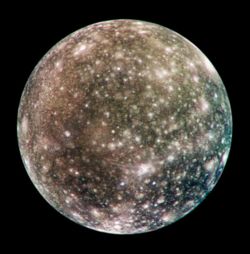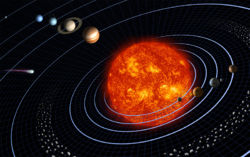Callisto
 From Conservapedia
From Conservapedia | Callisto | |
|---|---|
 True-color full-face image of Callisto by spacecraft Galileo. | |
| Date of discovery | January 7, 1610[1] |
| Name of discoverer | Galileo Galilei, Simon Marius[1] |
| Name origin | Nymph or daughter of Lycaeon, servant of Artemis, mistress of Zeus |
| Orbital characteristics | |
| Primary | Jupiter |
| Order from primary | 8 |
| Perizene | 1,868,768 km[2] |
| Apozene | 1,896,632 km[2] |
| Semi-major axis | 1,882,700 km[3] |
| Orbital eccentricity | 0.0074[3] |
| Sidereal month | 16.68902 da[3][4] |
| Avg. orbital speed | 8.21 km/s[4] |
| Inclination | 0.281°[4][5] to Jupiter's equator |
| Rotational characteristics | |
| Sidereal day | 16.68902 da[4] |
| Rotational speed | 10.50 m/s[2] |
| Physical characteristics | |
| Mass | 1.076 * 1023 kg (1.80% earth)[4] |
| Density | 1,834 kg/m³[6] |
| Mean radius | 2,410.3 km[6] |
| Surface gravity | 1.23577 m/s² (1.26014 g)[2] |
| Escape speed | 2.45 km/s[4] |
| Surface area | 73,004,909 km² (14.312% earth)[2] |
| Mean temperature | 126 K[7] |
| Maximum temperature | 168 K[7] |
| Composition | 60% rock and 40% ice[4][8] |
| Color | Gray-maroon-brown |
| Albedo | 0.20[4] |
Contents
- 1 Discovery and naming
- 2 Orbital characteristics
- 3 Physical characteristics
- 3.1 Surface
- 3.2 Interior
- 4 Problems for Uniformitarian Theory
- 5 Exploration
- 6 References
Discovery and naming[edit]
Galileo Galilei observed Jupiter beginning on January 7, 1610, with his famous telescope. He at first thought he had discovered three stars near Jupiter, but on the next night those "stars" seemed to have moved. He continued to observe Jupiter and its companion "stars" for seven days, during which time a fourth "star" (actually Ganymede) appeared and all four of these objects appeared to move with Jupiter. Finally he concluded that these objects were not stars at all, but satellites of Jupiter. This was the first direct observation that provided evidence for Nicolaus Copernicus's heliocentric model of the solar system.[1]
Simon Marius claimed to observe Jupiter and these satellites independently of Galileo and beginning five weeks earlier. However, he did not publish his findings, while Galileo published his. Furthermore, Galileo's notes were more reliable and extensive than those of Marius, which is why Ganymede and the three other satellites he observed (Io, Europa, and Callisto) are called the Galilean moons and not the Galilean-Marian moons.[1]
Marius does, however, receive credit for providing the names that the satellites have today. He named Ganymede, the largest, for the mythical son of King Tros of Troy, carried aloft to Mount Olympus by Zeus to be the cupbearer to the gods. (The names Zeus and Jupiter refer to the same classical deity from whom Jupiter gets its name.) The other three satellites are named for three of Zeus' most famous mistresses.[1] Marius propounded these names after Johannes Kepler suggested them to him.
Galileo, for his part, called them the "Medicean planets" after the Medici family and simply numbered the moons I, II, III, and IV. The satellites carried these names for two centuries until the discovery of other moons of Jupiter made that naming system untenably confusing.
Orbital characteristics[edit]
Callisto orbits Jupiter at a mean distance of about 1.9 million kilometers and takes 17 days to make a complete orbit around Jupiter (and a complete rotation on its own axis). Like other moons that orbit their primaries as closely as does Callisto, Callisto is tidally locked and keeps the same hemisphere toward Jupiter at all times. Callisto's orbit is more eccentric than those of the other Galilean moons (except for Europa), and is slightly inclined to Jupiter's equator.
Callisto does not resonate in its orbit with Ganymede and the other two Galilean moons; in fact its sidereal month is slightly more than twice as long as that of Ganymede. Callisto is, however, subject to tidal stresses on account of the eccentricity of its orbit.
Physical characteristics[edit]
Surface[edit]


Callisto has two very broad basins that most consider the result of repeated impacts. They are named for the two fabled homes of the Viking gods, Valhalla and Asgard.[9] Valhalla measures 3,000 km across; Asgard 1,600 km.[4]
Spectroscopy reveals a layer of solid carbon dioxide ("dry ice") on Callisto's surface and a thin, constantly escaping carbon-dioxide "atmosphere."[9][11]
Interior[edit]

Callisto has a very weak magnetic field that causes definite perturbations in the magnetic field of Jupiter as it passes in its orbit. Magnetic fields require currents, and current in turn require either metal or an electrolytic solution.[4] The most likely explanation is that Callisto has a saltwater ocean, which according to current models lies 200 km deep to the surface and is 10 km deep.[12] Further evidence in favor of this saltwater ocean lies in the relatively flat nature of the features of the Valhalla basin. Dr. David A. Williams of Arizona State University has long held that such an ocean must exist and help absorb the shock of meteoric impacts; the recent photographs of the region support this hypothesis.[13]
Problems for Uniformitarian Theory[edit]
Callisto and Ganymede are, according to uniformitarian theories, about the same age, and almost as old as the solar system. But the composition and surface features of Callisto and Ganymede are vastly different. Ganymede has a metallic core; Callisto has none. Ganymede's ocean is far deeper than is Callisto's. Ganymede's surface features are also far more pronounced than those of Callisto. This poses a problem for theories that insist that all processes that act on celestial bodies do so in a uniform fashion.[8]
Exploration[edit]
The first close observation of Callisto was by Voyager 1 and Voyager 2. The Galileo probe visited Callisto twice, in 1998 and again in 2001, in an effort to steer it toward Io, the last of its targets.[14]
No further intensive observation of Callisto is currently planned.
References[edit]
- ↑ 1.0 1.1 1.2 1.3 1.4 "The Discovery of the Galilean Satellites," JPL, NASA, n.d. Quoted by Hamilton, Calvin J., SolarViews. Accessed February 18, 2008.
- ↑ 2.0 2.1 2.2 2.3 2.4 Calculated
- ↑ 3.0 3.1 3.2 "Planetary Satellite Mean Orbital Parameters," Solar System Dynamics, JPL, NASA. Accessed March 1, 2008.
- ↑ 4.00 4.01 4.02 4.03 4.04 4.05 4.06 4.07 4.08 4.09 4.10 Hamilton, Calvin J. "Entry for Callisto." SolarViews, 2001. Accessed March 1, 2008.
- ↑ "Callisto: The Ancient Moon." Galileo at Jupiter. Accessed March 1, 2008.
- ↑ 6.0 6.1 "Planetary Satellite Physical Parameters." Solar System Dynamics, JPL, NASA. Accessed March 1, 2008.
- ↑ 7.0 7.1 "Callisto, a Continuing Story of Discovery." Galileo Project. Accessed March 1, 2008.
- ↑ 8.0 8.1 8.2 8.3 Arnett, Bill. "Entry for Callisto." The
Nine8 Planets, November 20, 2001. Accessed March 1, 2008. - ↑ 9.0 9.1 9.2 "Callisto (moon of Jupiter)." The Internet Encyclopedia of Science. Accessed March 1, 2008.
- ↑ "The Strange Spires of Callisto." Science@NASA. Accessed March 1, 2008.
- ↑ "Entry for Callisto." Encyclopædia Britannica 2008, Encyclopædia Britannica Online. Accessed March 1, 2008.
- ↑ "Catalog page for Image PIA01478." Jet Propulsion Laboratory, NASA, October 21, 1998. Accessed March 1, 2008.
- ↑ "Ocean Inside Jupiter's Moon Callisto May Have Cushioned Big Impact." NASA news release, November 29, 2001. Accessed March 1, 2008.
- ↑ Britt, Robert Roy. "Callisto Close-up: Galileo's Final Swing Past 'Ugly Duckling' Moon." <Space.com>, May 23, 2001. Accessed March 1, 2008.
| |||||||||||||||||||||||||||||
↧ Download as ZWI file | Last modified: 02/27/2023 11:25:51 | 72 views
☰ Source: https://www.conservapedia.com/Callisto | License: CC BY-SA 3.0
 ZWI signed:
ZWI signed:
 KSF
KSF